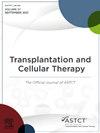Anti-CD19 CAR-T Cell Therapy in Elderly Patients: Multicentric Real-World Experience from GETH-TC/GELTAMO
IF 3.6
3区 医学
Q2 HEMATOLOGY
引用次数: 0
Abstract
Chimeric antigen receptor (CAR)-T cell therapy is approved for the treatment of relapsed/refractory (R/R) large B cell lymphoma (LBCL). However, elderly patients might not be candidates for this therapy due to its toxicity, and criteria for candidate selection are lacking. Our aim was to analyze efficacy and toxicity results of CAR-T cell therapy in the population of patients 70 years and older as compared to those obtained in younger patients in the real-world setting. A multicentric retrospective study was performed including patients with R/R aggressive LBCL who received commercial CAR-T cell therapy with either tisagenlecleucel or axicabtagene ciloleucel within the Spanish Group of Hematopoietic Transplant and Cell Therapy/Spanish Group of Lymphomas and Autologous Transplant (GETH-TC/GELTAMO) centers between 2019 and 2023. As of August 2023, 442 adult patients with aggressive LBCL underwent apheresis for CAR-T cell therapy as third or subsequent line and follow-up data was collected. Of 412 infused patients, 71 (17%) were 70 years or older. Baseline characteristics, product selection, and characteristics at apheresis (including disease status, Ann Arbor stage, revised international prognosis index (R-IPI), bulky disease, lactate dehydrogenase [LDH] and ECOG [Eastern Cooperative Group performance status]) were comparable between groups. Median time from both approval to infusion and apheresis to infusion did not differ. No differences were found between groups in overall and complete response rates at 1 and 3 months. With a median follow-up of 12.2 months (range 1-44), 12-month progression-free survival (PFS) and overall survival (OS) were comparable between groups (35.2% in <70 years vs. 35.9% in ≥70 years (P = .938) and 51.1% and 52.1% (P = .885), respectively). Age ≥70 years did not affect PFS (hazard ratio (HR) 0.98, P = .941) and OS (HR 0.97, P = .890) in the univariate and multivariate analysis. Cytokine release syndrome (CRS) was observed in 82% of patients <70 years old and 84.5% in ≥ 70 years old (P = .408). Grade ≥3 CRS was more frequent in the older group (5% vs. 15%, P = .002). In the multivariate analysis, age ≥70 years was associated with an increased risk of grade ≥3 CRS (OR 3.7, P = .013). No differences were observed in terms of overall neurotoxicity (35% vs. 42%, P = .281) or grade ≥3 (12% vs. 17%, P = .33). The proportion of patients with infections, admission to the intensive care unit within the first month, and non-relapse mortality were similar between both groups. CAR-T cell therapy in patients older than 70 years showed similar efficacy to that observed in younger patients in the real-world setting. However, age ≥70 years was an independent risk factor for grades 3-4 CRS. The need for additional strategies to reduce toxicity in this population should be addressed in future studies.
老年患者的抗 CD19 CAR-T 细胞疗法:GETH-TC/GELTAMO 的多中心真实世界经验。
背景:CAR-T 细胞疗法已被批准用于治疗复发/难治性(R/R)大 B 细胞淋巴瘤(LBCL)。然而,由于其毒性,老年患者可能并不适合这种疗法,而且也缺乏候选者选择标准。我们的目的是分析 CAR-T 细胞疗法在 70 岁及以上人群中的疗效和毒性结果,并与现实世界中年轻患者的疗效和毒性结果进行比较:进行了一项多中心回顾性研究,研究对象包括在2019年至2023年期间在西班牙GETH-TC/GELTAMO中心接受了tisagenlecleucel或axicabtagene ciloleucel商业CAR-T细胞疗法的R/R侵袭性LBCL患者:截至2023年8月,442名侵袭性LBCL成人患者接受了CAR-T细胞疗法的三线或后续治疗,并获得了随访数据。在412名输注患者中,有71人(17%)年龄在70岁或以上。两组患者的基线特征、产品选择和无细胞疗法时的特征(包括疾病状态、Ann Arbor分期、R-IPI、大块疾病、LDH和ECOG)具有可比性。从批准到输注和从血液净化到输注的中位时间没有差异。1个月和3个月后的总体反应率和完全反应率在各组之间没有差异。中位随访时间为12.2个月(1-44个月),12个月的无进展生存期(PFS)和总生存期(OS)在各组之间不相上下(结论为35.2%):在真实世界环境中,CAR-T细胞疗法对70岁以上患者的疗效与对年轻患者的疗效相似。然而,年龄≥70 岁是 3-4 级 CRS 的独立风险因素。在未来的研究中,需要采取更多策略来降低这一人群的毒性。
本文章由计算机程序翻译,如有差异,请以英文原文为准。
求助全文
约1分钟内获得全文
求助全文
来源期刊

Transplantation and Cellular Therapy
Medicine-Hematology
CiteScore
7.00
自引率
15.60%
发文量
1061
审稿时长
51 days
 求助内容:
求助内容: 应助结果提醒方式:
应助结果提醒方式:


